The first day of Asian Network for Quality (ANQ) Congress 2017 in Soaltee Crowne Plaza Hotel, Kathmandu, Nepal was held on 20 Sep 2017. The
congress theme was “Quality Culture for Sustainable Prosperity”. Before the
congress, Minda and I took a photo in front of the entrance.
During
registration, I met Mr.
Janardan Ghimire (President, NQPCN) and Mrs. Bindu Manandhar (EC member, NQPCN). We took a photo for memory.
Minda helped the registration affairs for Hong Kong Society for Quality (HKSQ) members.
In the
congress hall, we took a group photo with Prof. Kano, CAQ, CSQ, SQI, SQAT and
HKSQ.
HKSQ group
(5 representatives) photo was taken during the congress.
(Left:
Dr. Inez M Zwetsloot (CityU), Dr. KS Chin, Mr. Peter Fung, Ms. Minda Chiang and
I)During the opening of ANQ Congress 2017, a Nepal traditional performance included music and dancing were performed. (See short video below)
Plenary Session 1: Opening of Congress
In the beginning, Mr. Janardan Ghimire (President, NQPCN) gave
a welcome speech and he would like to extend a warm welcome to all
distinguished guests and delegates at Kathmandu, the resilience valley of the
Himalayas and capital of Nepal. The congress would focus on sharing novel ideas
on crucial quality culture, issues and trends on the theme of “Quality Culture
for Sustainable Prosperity”.
Inauguration
by Chief Guest – Hon. Minister, Sunil Bahadur Thapa (Minister of Industry) to
lighting the Panas.
Then Prof.
Azat Abdrakhmanov (President, ANQ) gave an opening speech and briefed ANQ way
to all participants.
Chief
Guest speech was performed by Hon. Minister, Sunil Bahadur Thapa (Minister of
Industry) and he said QC in products and services were important. This morning we would learnt the best
practices that could be better live and better quality in different parties
such as supply chain. Quality Culture in
prosperity we got good
experience for Nepal through ANQ Congress.
The
first keynote speaker was Prof. Noriaki Kano (Honorary Chairperson, ANQ) and
his presentation topic entitled “Service Quality Management in the New Era”. Firstly, he suggested Nepal should stop
manufacturing and focused on service industry because of sandwich by the two
gigantic countries (China and India) and god bless with Himalaya. Moreover, he suggested changing time zone
(UTC) to India time or Bangladesh time so as to convenient for tourists.
Prof.
Kano reviewed his book “TQM in Service Industries” which had published about 30
years ago. Some cases studies of TQM
implementation in the service sector included resort hotel, electric power
company, retail store, after-sales service company, financial institution,
trading company, etc. Then Prof. Kano
analyzed the growth of service industries in Asia and classification of service
industries. He said the top four GDP
growth service industries in Japan from 1970 to 2015 were “Health / Sanitation
/ Social Welfare”, “Information / Communication”, “Expert / Scientific /
Technical Services” and “Wholesale / Retailer”.
After
that Prof. Kano told us the three activities elements of TQM in Service
Industries and they were Humanware (people’s work), hardware (building,
equipment, measurement tools, etc.) and software (system, IT, ICT, etc.) He also raised an example of lodging service
(hotel) as follows:
Hardware (H/W): guest room, bathroom, TV, telephone, safety
box, etc.
Software (S/W): price system, check-in/out time, morning
call, laundry service system, directory, restaurant menu, etc.
Humanware (Hmn/W): housekeeping a guestroom, room
service operator response, manner of staff at check-in/out, behavior of
waiter/waitress, etc.
Finally,
Prof. Kano discussed the different concepts on products and services between
1980s and the New Era. In new era, on
time delivery was very essential for servicing.
Hmn/W focused servicing or for tailor-made services, the flexibility or
the ability to adapt to specific circumstances (awareness, observation, and
attention), on-the-spot customization and thinking ahead was required. Lastly,
Prof. Kano concluded that “Service Quality is not only dependent on humanware
but also hardware and software.
Therefore, the application of process management and control by data
that was considered difficult will be popular in TQM promotion in
servicing. The gap between service
quality management and product quality management will be reducing with the
lapse of time.”
At the
end, I asked a question that what is different between peopleware and
humanware. Prof. Kano replied that was
the same. However, I thought that the
coverage of humanware should be larger.
Prof.
Azat Abdrakhmanov
and Mr. Janardan
Ghimire presented an appreciation certification to Prof. Noriaki Kano.
During
the tea break, I took many photos with ANQ friends for memory.
Photo of HKSQ and CAQ
(Left: Dr. KS Chin, Ms. Wang (王麗林), Prof. Tang Xiaoqing (唐曉青) (Vice-chairperson, CAQ), I and Dr. Inez M Zwetsloot)
WACQ
group photo included CAQ, CSQ, SQI and HKSQ
(Left:
I, Liu Xiaosong, Mr. Kenneth Liang, Ms. Wang, Prof. Ching-Chow Yang (楊錦洲), Mr. Tan Gheng Een, Prof.
Kuan Sheng-Pin (官生平), Dr. KS
Chin and Mr. Han Ling (韓岭) (Sr. Manager, International Exchange Department, CAQ))
I took a photo with Prof. Dinesh P. Chapagain (Founder President and Advisor of NQPCN, Nepal)
(Left: Mr. Too Meng Ken (SQI), Dr.
Thanakom Soontornchainacksaeng, Dr. Panisuan Jamnarnwej (SQAT), I, Prof.
Phulporn Saengbangpla (SQAT), Dr. Yury Gusakov (ROQ) and Ms. Gulbakhram Aitkhozhina (ROQ))
Minda
took a photo with Prof.
Phulporn Saengbangpia (Honary Advisor, SQAT) (HK gift - Moon cake)
Photo
with Mr. Janak Mehta (ISQ)
Photo
with Prof. Sung Hyun Park (KSQM)
Then we
went for a coffee.
I took a
photo with Ms. Wang and Mr. & Mrs. Kuan.
Minda
and I took a photo with Prof. Kano.
Then I
took a photo with Nepal’s friends.
I also
met two of IAQ friends and took photos for memory again.
Photo
with Mr. J. Ravikant (Associate Vice President & Head TQM, SRF)Photo with Mr. Anil Sachdev (President, TQMI)
Photo
with Prof. Uk Jung (Professor, Operations Management School of Business,
Dongguk University)
Plenary Session 2:
The second
key speaker was Prof. Azat
Abdrakhmanov (President, ANQ) and his presentation topic named “Global risks
and threats – how the Quality will allow us to overcome them”. In the beginning, Prof. Azat pointed out many
threats, crises and challenges in the modern world such as wars, regional
conflicts, uncontrolled migration, economic crises, unemployment, poverty,
ecological and technologic catastrophes, globalization and social negative
factors, etc. He said Quality Management
as a philosophy could prevent or reduce some negative consequences of many of
threats and challenges.
Prof.
Azat also mentioned some benefits of globalization included Foreign Direct
Investments (FDI), Technological Innovation and Economies of Scale
effects. On the other hand, it had some
risks of globalization included Interdependence, National Sovereignty and Equity
Distribution. Then He quoted the Global
Risks Report 2016 and Global Risks Interconnections Map 2016.
Prof.
Azat explained the role of Quality Management in the current environment and
quoted Henry Hazlitt “reveals that economics and ethics are, in fact,
intimately related. Both are concerned
with human action, human conduct, human decision, human choice …” After that
Prof. Azat introduced new approach to strengthening organizational culture
through the four parts of model and they were “Actions of Funders or Leaders”, “Culturally
Consistent Rewards”, Aligning Artifacts” and “Selecting and Socializing
Employees”.
Finally,
Prof. Azat discussed new business concepts included business excellence model
(EFQM and MBNQA), Innovations and benchmarking, as well as Sustainable
development, etc. Lastly, he concluded
that we were not able to exclude crises and threats from our lives. Therefore, we should be prepared for them (risk
management) to reduce or avoid negative consequences. ANQ as an Organization which united National
Quality Organizations had defined “ANQ Way” – its goal is to improve the
quality of life of the population in all Asia Region and in each of our
countries.
The
third key speaker was Mr. Janak Mehta (Chair, IAQ) and his topic entitled “IOT
as Enabler for creating Quality Culture and Sustainable Prosperity”. Firstly, Mr. Mehta aligned his talk with the
theme that Quality Culture is a way of life for benefit of all included Respect
humanity, Fact based, Self-discipline and Customer focused; Sustainable
Prosperity – over a long period of time that long term prosperity rather than
short term profit, benefit for all stakeholders and all living beings.
Then he
mentioned some key issues for Quality Improvement and those key issues were
related to data. (e.g. Reliability of data, Time taken to collect data, real
use conditions data, errors in transmission of data, etc.) Such data could be
gathered in real time, in large numbers and accurately that enable quality
professionals and problem solvers to achieve much higher level of improvement
in shorter time.
After
that Mr. Mehta shared a case study “Intangles – Proprietary Design &
Technology”. Based on the customer
requirement study and identification, the company employed IoT to perform “Predictive
vehicle health monitoring”, “Fuel monitoring”, “Driving Behavior Analysis”, “Vehicle
Tracking”, etc. Company performed extensive study to understand customer pain points
and through IOT specialist to develop hardware, software and algorithm for data
collection, analysis, validation, etc.
At the
end, Mr. Janak Mehta concluded that role of Quality Professional should
understand the key issues and pain through interaction with the customer
through on site, in field observations.
Technology team needed to develop the hardware and the software to
capture the data, analyzed and presented in easily understandable way like a
dash board. Lastly, to use the
information generate and help the customer to overcome technical and operational
issues through structured improvement process.
The Ishikawa-Kano (IKA) award 2017 winner was Mr. Qin Yufeng (President Dong EE Jiao Corporation Limited, PRC). He has more than 30 years’ solid experiences in manufacturing industry, specifically the traditional Chinese medicine industry. Qin has demonstrated significant achievement and advancement in quality discipline by developing and implementing a successful supply chain based quality control mechanism and an innovative GAP traceability system.
Another IKA winner was Mr. Segey Katyrin (President of Russian Chamber of Commerce and Industry (CCT)). He has over 25 years’ experience in the Chamber of Commerce and Industry of Russian Federation. He is taking active part in development of the new Russian Federal law of “On Standardization in Russian Federation” and initiated the inclusion of special article on quality into draft Federal Law “One development of agriculture in Russian Federation”. Mr. Katyrin’s main contribution to quality is in the policy making area at macro level. Since Mr. Katyrin was not able to join the congress, Dr. Yury Gusakov (Senior VP and CEO, ROQ) represented him to get the award.
During the lunch time, we took a group photo and with India friends Mr. J. Ravikant (Associate Vice President & Head TQM, SRF) (Left) and Mr. Neeraj Chandna (Vice President TQM, SRF)
I met IKA award 2017 winner Mr. Qin Yufeng and took a photo for memory.
I took photo with Singapore friends.
I also met Vietnam friends Dr. Pham Xuan Thu (Dean-Business Administration School, College of Foreign Economic Relations) and Ms. Le Thi Giang Phuang.
Technical Session – I (Parallel Session I)
I joined
the parallel session I for Six Sigma.
The
first speaker was Mr. Too Meng Ken (Lecturer, SQI) and his presentation topic
entitled “Improvement of Credit Risk Management in the Mining Industry through
Lean Six Sigma Methodology”. Firstly,
Mr. Too introduced the products of that mining industry included Iron Ore,
Copper, Diamond, Coal, Platinum and Nickel.
Then he briefed the marketing risk management strategy included Market
Risk and Credit Risk.
Mr. Too
employed Lean Six Sigma to handle Credit Risk using DMAIC six sigma approaches and included Lean for
improvement stage. In define phase, Mr.
Too showed us some operational definition of key terms such as Near Miss due to
human error, minor incident and inadequate processes or systems which were
corresponded to Credit Breach (Breach of any defined authorizations, Major
incident and Material financial consequences).
The goal statement was to reduce lead time in invoice booking and cash
application by 50% from baseline 2015.
They achieved to reduce credit limit breaches to zero by April
2016. Finally, value stream mapping was
employed for future state.
The
second speaker was Dr. Inez M Zwetsloot (Asst. Professor, SEEM, CityU) and her
topic was “Lean Six Sigma meets Data Science – Integrating two approaches based
on 3 case-studies”. There were four
elements of Lean Six Sigma (LSS) to establish continuous improvement included “Parallel-meso
structure”, “Improvement specialist leads the project”, “Structured roadmap
called DMAIC” and “Improve performance metrics”.
Dr. Inez
also described that “Data science is utilizing large data sets to provide
insights”. She found the differences
between data science LSS and the traditional elements of LSS.
Therefore,
she modified LSS framework in order to facilitate data science such as
including data scientists in organizational structure & teams, cross train
data scientists and black belts, as well as, allow for iterations in DMAIC
structure.
During
Q&A discussion, Dr. KS Chin suggested SSBB should learn some knowledge
about data science so as to better fusion of LSS and Data Science.
The
third speaker was Mr. Yao-Chang Wang (Unimicron Technology Corp. (Taiwan)) and
his presentation subject named “Build up AOI Trace Nick (O4) Defect Improvement”.
Mr. Wang briefed Unimicron which was one of world leading PCB companies. Then he introduced Flip Chip Ball Grid Array
(FCBGA) which was between IC and PCB to avoid IC damage causing by PCB
warping. Fine Line Space (FLS) was an
ultra-fine pitch circuit smaller than 50 um produced by Lithography –
Semi-Additive Process (SAP).
Mr. Wang’s
studied based on three hypotheses that would impact the process flow. Then he did the potential cause verification
for defects. He concluded the project utilized
six sigma methodologies to find out the critical factors. After screening out the potential causes, the
key factors for clean roller material properties were determined and
improvement actions were implemented.
They reduced O4 defect rate from 1.78% to 0.22% (Target <1.0%).
The fourth speaker was Mr. Deepak Bansal (TQM International Pvt. Ltd., India) and his presentation topic was “Business Transformation through Application of Lean Six Sigma in a Bulk Drug Pharmaceutical Company”. Mr. Bansal briefed the company in the field of Phytochemicals over 1000 employees worldwide with three manufacturing sites across India. The managing director decided to go for “Business Transformation” with LSS in three phase approach which was Pilot -> Expansion -> Replication.
LSS
approach followed the framework DMAIC was described by Mr. Bansal. In Pilot
phase, monetary gains were not calculated and declared just to ensure that
employees did not treat this initiative as a cost saving initiative but as a
strategy for Business Transformation. In
Expansion phase, Governance structure was put into place with dedication team
(contain 1 Black Belt and 2 Green Belts).
QA projects were mainly on the theme of variation reduction in testing
(e.g. using MSA) and Financial gains were now calculated. Employees then were
proposing the projects rather than senior people allocating the project that
changed from “Push to Pull” DNA of the company.
NQPCN
representative presented the appreciation certificate to Mr. J. Ravikant (Associate Vice
President & Head TQM, SRF) for servicing as session chair.
Technical Session – II (Parallel Session II)
I
serviced as session chair in Performance Management (PMT) session.
The
first speaker was Ms. Youngju Park (PhD Candidate, Graduate School of Business,
Soongsil University) and her topic named “A Study on the Decisive Factors of
Productivity of Global Mobile Telecommunications Operators”. She introduced the objectives of her studies
included efficiency analyzed the world’s main mobile carriers, finding measures
for efficiency increase of Korea’s mobile carriers and analyze the relative
change in productivity of mobile carriers.
She employed the Malmquist Productivity Index (MPI) by Fare et al. (1994)
for her study.
Ms. Park
concluded S. Korea, Republic of South Arica and Argentina that had high
technical advancement but low the operation efficiency for productivity
improvement. So S. Korea’s speed of
technical advancement from 2G to 4G should increase but large marketing cost
needed to expanse (means large deadweight loss). During Q&A session, I asked when S. Korea
had 5G. She consulted by her teacher and
replied that it may be in 2020.
The
second speaker was Mr. Yukihiro Ando (TQM Consultant, Japanese Society for
Quality Control) and his topic entitled “Introduction to Guidelines for Policy
Management JSQC-Std 33-001(E): 2017”. He
said there was a standard for “Policy Management” as JIS Q 9023:2003. During development of this Guideline, it had
been adapted as JIS Q9026:2016.
Then Mr.
Ando introduced the whole set of relevant JSQC standards. Policy Management is “Activities to achieve
policies by unity of purpose and priority approach with engagement of all
functions and levels”. And Policy is defined as “Overall intentions and
direction of an organization, formally expressed by top management, relating to
achievement of mission, principles, vision and mid-and-long-term business plan
of organization”. (JSQC-Std. 00-001:2007)
After
that Mr. Ando briefed the key concepts of policy management included three
streams of policy management, various types of PDCA cycles and founding
principles. The structure of the
standard was mentioned.
During
Q&A, Minda asked any case about “6.5 - Mental attitude as a manager” for
sharing. Mr. Ando shared that manager
should define the objectives of today to achieve company policy.
The
third speaker was Mr. Wichaya Phanidanant (SCG Packaging Co., Ltd. Thailand)
and his presentation topic was “Sheet Break Reduction in Siam Nippon Paper
Industry”. Firstly, Mr. Phanidanant
introduced his company’s products included Printing, Packaging and Industrial
use paper. There was a challenge for
paper making that the sheet break loss time was the obstacles to increase the
speed of machine (productivity).
Mr.
Wichaya Phanidanant presented the definition of the problem and followed the
sequence from Observation, Analysis, Action, Check, Standardization and Result
to present his project. Finally, they
solved the problem and increase the productivity.
Prof.
Sheng-Pin Kuan (CSQ / QKC-Quality Knowledge Community, Taipei) was the fourth
speaker and his presentation topic named “What Roles can Quality Organizations
play under “One Belt One Road” Initiative”.
He quoted that somebody said “The 21st century will be the
century of China” and it seems true. “One
Belt One Road (OBOR)” is a grand scheme for knitting a network of roads, ports,
railroads and other links from East China through Southeast and South and
Central Asia to Europe. It actually is
century engineering!
Then
Prof. Kuan quoted Dr. Sun Yat Sen statement to explain that we needed to follow
the trend. So that ANQ would consider the trend and think our role under OBOR
initiative.
Lastly,
Prof. Kuan purposed each member of ANQ should have a role in OBOR Economic
Corridors. Moreover, he suggested the
quality activities organized by government organization, nonprofit
organization, profit organization in each economic corridor and such activities
included “Public Service TQM”, “Excellent Performance Management”, “Sustainable
Management System”, “Continual Improvement Mechanism”, “Quality Professional
Training and Certification” and “Product Reliability and Safety Certification”. Therefore, we could form Global Platform for
Quality. At the end, Prof. Kuan used a
news “Nepal signs mega hydro project deal with Chinese firm” as conclusion that
organization members of ANQ should take into account on OBOR.
I as
session chair presented the speaker certificate to Prof. Sheng-Pin Kuan.
The last
speaker of this session was Mr. Amit Patnaik (Senior Manager, Planning &
Scheduling – Steel & HR, KPO, Flat Products Planning, TATA Steel Limited)
and his presentation was “Planning and Scheduling System Tata Steel
Kalinganagar (TSK)”. Firstly, Mr.
Patnaik briefed Tata Steel India operation since 1907. Annual crude steel capacity across Indian
operations was nearly 13 MnTPA with a turnover of US $7889 Mn in FY 2017. Their vision was “We aspire to be the global
steel industry benchmark for Value Creation and Corporate Citizenship”.
Then Mr.
Patnaik introduced the overall supply chain system design of TSK from “order
logging” to “manufacturing execution system (MES)”. He proposed two solutions (Part 1 & 2) in
different position of the supply chain. The solution separated into three parts
and they were Business Process, Design Six Sigma (DSS) and Experience. He
concluded that the key KPI improved in Plan Compliance, Slab Inventory, Average
Edging and Lead Time.
At the
end of this session, Mr. Dipesh Shrestha (Executive Member, NQPCN) presented
the appreciation certificate to me for the session chair contribution.
Technical Session – III (Parallel Session
III)
My
presentation was in Quality and Innovation (QIN) session. Since I needed to
join IAQ dinner, I reschedule my presentation to be the first speaker. My presentation topic entitled “Quality
Innovation – Introduction of Extenics and Integrated System Approach”. In the
beginning, I explained the different about “Quality & Innovation”, “Quality
Innovation” and “Innovation Quality”.
Then I
reviewed the history of Quality and Innovation development and tools. For innovation, it mainly started from Trial
& Error to Brainstorming. The
breakthrough was TRIZ at 70 years ago. However, the actual innovation theory
for solving contradiction I found was “Extenics” at 33 years ago.
After
that I introduced Prof. Cai Wen (蔡文) (Founder of Extenics and The Director of
International Academy of Extenics (HK)) who started his study on 1976 and
published his first paper named “Extension Set and Incompatible Problem” in
1983. He employed formal model to
research the extension possibility of things and then used to solve
contradictory problems.
I had
studied “Extenics” for one year and followed Prof. Cai Wen’s train-the-trainer
class for 12 days in April and May 2017.
I understood the theory behind and discovered how clever Prof. Cai
is. The Extension Set was the core of
the Extencis and Prof. Cai only added the transformation part (in red color) in
the Set theory equation.
Then I
introduced the “Basic-element” which included Matter-element, Affair-element
and Relation-element. I used “Stack” as
example which was my exercise in the training.
The
Conjugate Analysis was one of important concepts in the Extenics. It viewed anythings into four dimension and
they were “Physical (Nonmaterial Part vs Material Part)”, “Systematic (Soft
Part vs Hard Part)”, “Dynamic (Latent Part vs Apparent Part)” and “Antithetic
(Negative Part vs Positive Part)”.
Finally,
I proposed the Integrated Approach for three key innovation methodology and
they were TRIZ (RUSSIA), Extenics (CHINA) and Innovation Culture (USA).
At the end, I used my company case for service innovation using Extenics. One of our projects named Quality Startup Scheme was implemented.
Dr.
Thanakom Soontornchainacksaeng (Asso. Professor, Department of Mechanical and
Aerospace Engineering, Faculty of Engineering, King Mongkut’s University of
Technology North Bangkok) was this session chair and presented a speaker
certification to me.
Reference:
Asian Network for Quality (ANQ) - http://www.anforq.org/
20170918:
ANQ-CEC Meeting 2017 in Nepal - https://qualityalchemist.blogspot.hk/2017/09/anq-cec-meeting-2017-in-nepal.html
20160920:
ANQ Congress 2017 Kathmandu, Nepal – Day 1 - https://qualityalchemist.blogspot.hk/2017/09/anq-congress-2017-kathmandu-nepal-day-1_20.html
20160921:
ANQ Congress 2017 Kathmandu,
Nepal – Day 2 -
https://qualityalchemist.blogspot.hk/2017/09/anq-congress-2017-kathmandu-nepal-day-2.html
20160921:
ANQ Congress 2017 Kathmandu, Nepal – Gala
Dinner - https://qualityalchemist.blogspot.hk/2017/09/anq-congress-2017-kathmandu-nepal-gala.html




















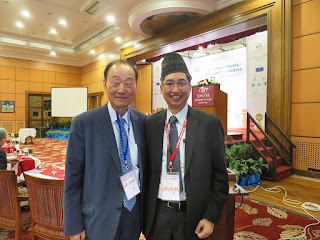








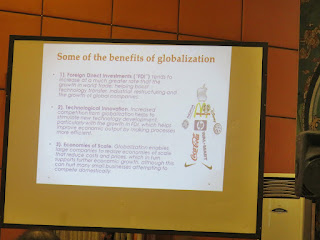







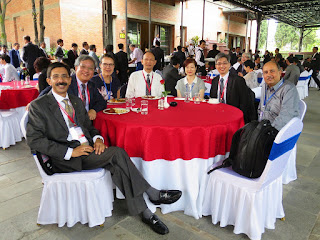












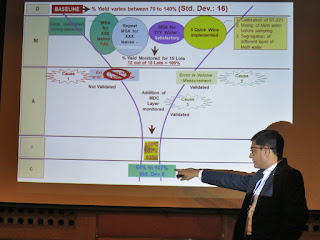
















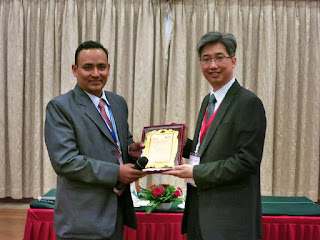
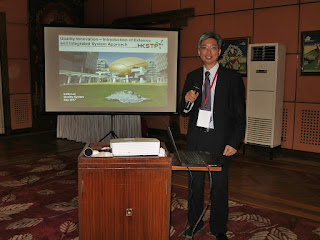








沒有留言:
發佈留言